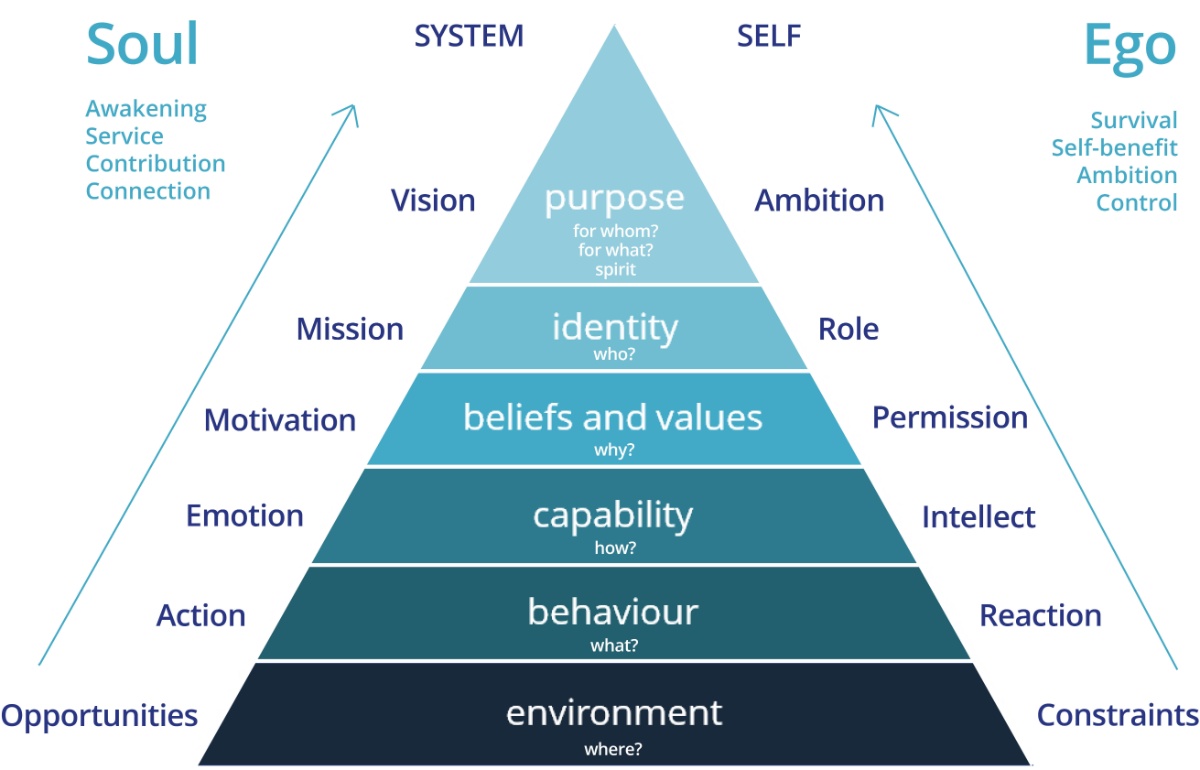3 June 2020: Balancing your boat in choppy waters
As we begin to chart these new waters, we have established that having better tools at our disposal, will allow us to make greater headway in bringing about the change we need.
Today, I want to explore another useful tool to support that crucial change.
Since Robert Dilts first developed the logical levels model in the 1970’s, he has continued to enhance it. This improved model is referred to as the Extended Logical Levels Model and it enables leaders and organisations to identify not only their level of alignment, but also their degree of balance.
And balance in choppy waters is a great thing to have!
Let’s take a look at the Extended Logical Levels Model:

Here, you can see that at each logical level, two new dimensions are applied. It is these paired dimensions that enable us to calibrate how balanced we are at each level.
Navigating the model
Let’s take a look at each level in turn and remember as I take you through the dimensions - neither is 'right' or 'wrong', ‘good’ or ‘bad’. Different scenarios and times may require us to focus on one more than the other.
Let's start with your environment:
At the level of your environment: what are the constraints and/or opportunities that you notice or are looking out for?
Our ability to respond creatively and wisely is a key factor determining anything from our survival through to our success. In times of stress and change, it is important to scan our environments for danger and problems, but if that’s all we look for we might not see the opportunities that the current situation can offer.
In my own business, we were just about to run our first lli Coach Workshop when lockdown was announced. The physical course was cancelled.
The opportunity presented by conferencing platforms such a Zoom has enabled us to convert those workshops to a virtual environment, which has opened our training up a much wider market.
Moving up to behaviour:
Behaviour is the concrete activities we engage in. Are you waiting for the situation to be right before you react (reaction) and\or are you taking action (proactive), making decisions and thinking ahead?
In the McKinsey article ‘Reimagining the post-pandemic organisation’ (15 May 2020), the authors give many examples of organisations that have inspiring stories of positive change and rapid action including a large retailer that dusted off a pre-pandemic initiative to launch a kerbside delivery.
The workplan said it would take 18 months – it went into operation in two days after lockdown hit. They took action!
Our capabilities:
These relate to our inner maps and knowledge and direct how our behaviour is selected and monitored. At this level do you connect to your conscious cognitive intelligence (IQ), such as analysis and strategy and/or do you draw on your emotional intelligence (EQ) – managing the emotions of self and others and building relationships?
There is a need for organisations and governments to intelligently analyse a lot of data and then make difficult decisions: how to keep people working from home, when to furlough staff, when to lay off staff, when to go back to work, etc.
At the same time there has never been a greater need to build relationships. The Thursday evening ‘clap’ for our amazing NHS staff working on the front line was a nation displaying an emotional connection to a dedicated group of people.
Beliefs and values:
Our beliefs support or inhibit which capabilities and behaviours we use. Our values, because they are connected to ‘worth’, are a primary source of impetus in our lives. Thinking about your beliefs and values, are you motivated by what you ought to do focusing on safety, approval, control, achievement and self-benefit (permission) and/or are you motivated by your focus on connection, desire, choice and possibility (motivation)?
Right now, there is a need to do both. I was recently coaching a manager who had to let all his staff know all the safety precautions he was taking to ensure they remained safe when returning to work.
He knew he should do this (permission) but he wanted to engage with his staff so he chose to make a video about it to connect with them (motivation) rather than send out a memo.
The identity level:
At this level, leaders lead through their ‘being’. Do you connect to your role – the position you occupy together with what you do in your role and /or do you connect to your mission – your contribution to your organisation and its vision, or the contribution to your life’s vision and the unique gifts you bring to the world?
Many people in this pandemic may lose their roles. If who we are is defined by what we do, when we lose that role, we can feel lost and literally not know who we are any more.
However, if our identity is connected to something bigger than our role (through our mission), we will weather the storm and any potential loss or change of role so much better
The last level, purpose:
This relates to the larger system that you are part of. It determines the overall direction and meaning behind the actions, capabilities and identity of an individual, team or organisation. This is the strongest of all motivations. Thinking about purpose, is your motivation to achieve success and recognition for yourself (ambition) and/or to achieve your vision of what you want to create in the world that includes you but is not about you?
Many organisations’ ambition has been to make more money and increase shareholder value in the short term. However, subsequent to this pandemic, I believe we may see a shift towards longer term ambitions such as the triple bottom line - profit, people and planet.
The opportunities for organisations to re-align their ambition statement due to the pandemic are there for the taking.
As for vision, those organisations that have a clear vision have inbuilt strong motivations that drive performance.
The challenge for organisations and leaders is to keep their vision and ambition in balance; the larger the ambition – the larger the vision needs to be, and vice versa.
The power of balance
The pairing of the dimensions at each level can relate to an individual, a team and an organisation. Effective individual leadership requires balance at all levels, especially the highest levels of identity and purpose.

How to explore your level of balance at each of the levels
To gain some insights into the level of balance you have at each of the levels, here is a short exercise you can do. Read the descriptions of each of the two dimensions that operate at each level and notice which one resonates with you the most.
Next, sit with both feet firmly resting on the floor – straighten your back and bring your body into balance. Starting with the level of environment imagine you have the dimension of ‘constraints’ in one hand and the dimension of ‘opportunities’ in your other hand. Which hand feels heavier or lighter? Which feels more familiar to you? Do your hands feel balanced? What would it take for your hands to feel more balanced?
Carry on up through the levels until you have tested all six levels.
When I do this exercise, the dimension I connect to the most feels lighter and I notice the hand that holds that dimension wants to rise. For some people, the dimension that is more familiar is more solid and heavy. My recommendation is to play with this and simply notice what you notice.
With greater balance, you will captain your ship with greater ease.

The two sides of the Extended Logical Levels Model are referred to as the ‘soul’ and the ‘ego’, and I will explore this more in my next article on the logical levels.
In the meantime, if you wish to explore how our exciting new online profiling tool might help your clients or your leaders better understand their alignment and balance, please get in touch with us at info@logicallevels.co.uk.
Until then, please stay safe.
Hilary Barnett, co-founder, Logical Levels Inventory (lli)

